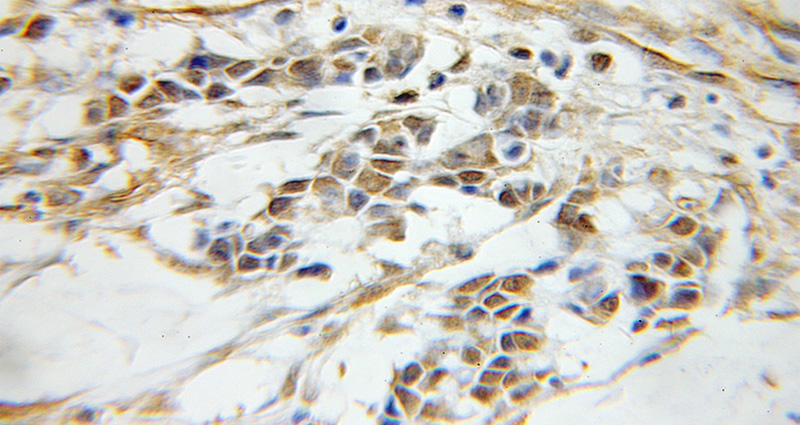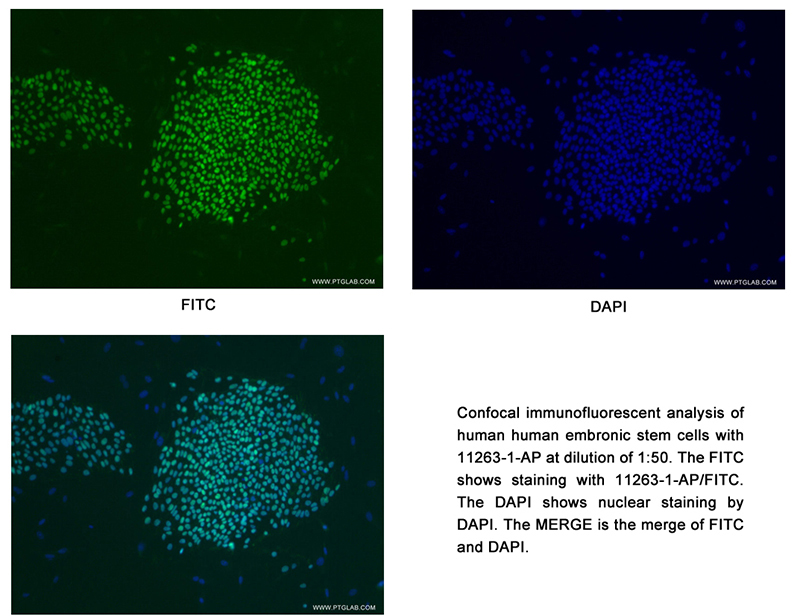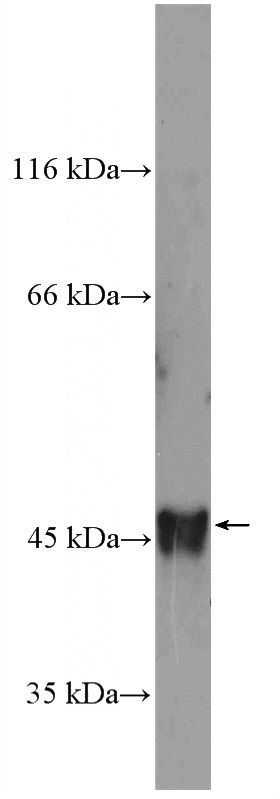-
Product Name
OCT4 antibody
- Documents
-
Description
OCT4 Rabbit Polyclonal antibody. Positive IF detected in human embronic stem cells. Positive IHC detected in human colon cancer tissue. Positive WB detected in H7ES cells, HEK-293 cells, hESC cells, mouse brain tissue, mouse kidney tissue. Observed molecular weight by Western-blot: 50kd
-
Tested applications
ELISA, IHC, IF, WB
-
Species reactivity
Human,Mouse,Rat; other species not tested.
-
Alternative names
OCt 3 antibody; OCt 4 antibody; OCT3 antibody; OCT3/4 antibody; OCT4 antibody; OCtamer binding protein 3 antibody; OCtamer binding protein 4 antibody; OTF 3 antibody; OTF3 antibody; OTF4 antibody; POU class 5 homeobox 1 antibody; POU5F1 antibody
-
Isotype
Rabbit IgG
-
Preparation
This antibody was obtained by immunization of ℃T4 recombinant protein (Accession Number: BC020712). Purification method: Antigen affinity purified.
-
Clonality
Polyclonal
-
Formulation
PBS with 0.02% sodium azide and 50% glycerol pH 7.3.
-
Storage instructions
Store at -20℃. DO NOT ALIQUOT
-
Applications
Recommended Dilution:
WB: 1:500-1:5000
IHC: 1:20-1:200
IF: 1:20-1:200
-
Validations

Immunohistochemical of paraffin-embedded human colon cancer using Catalog No:113318(ocT4 antibody) at dilution of 1:50 (under 10x lens)

Confocal immunofluorescent analysis of human embronic stem cells with Catalog No:113318 at dilution of 1:50. The FITC shows staining with Catalog No:113318/FITC. The DAPI shows nuclear staining by DAPI. The MERGE is the merge of FITC and DAPI.

H7ES cells were subjected to SDS PAGE followed by western blot with Catalog No:113318(ocT4 Antibody) at dilution of 1:1000
-
Background
Expression of the oct-4 transcription factor is associated with an undifferentiated phenotype of human and mouse embryonic stem cells and germ cells. oct-4 (octamer-4) is a homeodomain transcription factor of the POU family (POU5F1) involved in regulation of pluripotency during normal development and is detectable in embryonic stem (ES) and germ cells. Its expression is associated with an undifferentiated phenotype and tumors. In fact, gene knockdown of oct4 promotes differentiation, thereby demonstrating a role for this factor in human ES cell self-renewal. As such, it is frequently used as a marker for undifferentiated ES cells or iPS (induced pluripotent stem) cells. oct4 is one of the four key transcription factors (oct4, Sox2, c-Myc, and KLF4) used to reprogram mouse and human fibroblasts to a pluripotent state as well as generate patient-specific iPS cells. Affinity purified rabbit anti-oct4 can be used to demonstrate pluripotency of ES and iPS cells.
-
References
- Persano L, Pistollato F, Rampazzo E. BMP2 sensitizes glioblastoma stem-like cells to Temozolomide by affecting HIF-1α stability and MGMT expression. Cell death & disease. 3:e412. 2012.
- You X, Liu F, Zhang T. Hepatitis B virus X protein upregulates Lin28A/Lin28B through Sp-1/c-Myc to enhance the proliferation of hepatoma cells. Oncogene. 33(4):449-60. 2014.
- Huang CF, Xu XR, Wu TF, Sun ZJ, Zhang WF. Correlation of ALDH1, CD44, OCT4 and SOX2 in tongue squamous cell carcinoma and their association with disease progression and prognosis. Journal of oral pathology & medicine : official publication of the International Association of Oral Pathologists and the American Academy of Oral Pathology. 43(7):492-8. 2014.
- Tao H, Li H, Su Y. Histone methyltransferase G9a and H3K9 dimethylation inhibit the self-renewal of glioma cancer stem cells. Molecular and cellular biochemistry. 394(1-2):23-30. 2014.
- Peng Z, Liu L, Wei X, Ling J. Expression of Oct-4, SOX-2, and MYC in dental papilla cells and dental follicle cells during in-vivo tooth development and in-vitro co-culture. European journal of oral sciences. 122(4):251-8. 2014.
- Kong D, Su G, Zha L. Coexpression of HMGA2 and Oct4 predicts an unfavorable prognosis in human gastric cancer. Medical oncology (Northwood, London, England). 31(8):130. 2014.
- Zheng Y, Zou F, Wang J. Photodynamic therapy-mediated cancer vaccination enhances stem-like phenotype and immune escape, which can be blocked by thrombospondin-1 signaling through CD47 receptor protein. The Journal of biological chemistry. 290(14):8975-86. 2015.
- Kissing S, Hermsen C, Repnik U. Vacuolar ATPase in phagosome-lysosome fusion. The Journal of biological chemistry. 290(22):14166-80. 2015.
Related Products / Services
Please note: All products are "FOR RESEARCH USE ONLY AND ARE NOT INTENDED FOR DIAGNOSTIC OR THERAPEUTIC USE"
